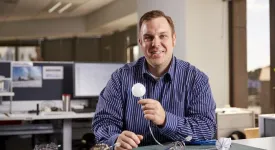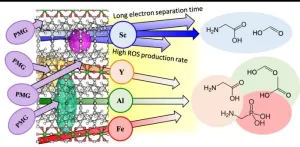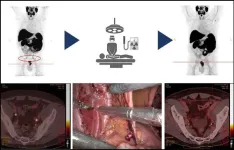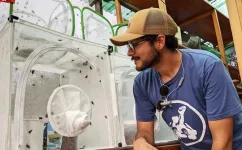(Press-News.org) The endoscopic mapping device, developed over more than a decade by scientists at the Auckland Bioengineering Institute, consists of an inflatable sphere covered in sensors, delivered down the oesophagus and able to measure electrical activity in the gut.
In the same way abnormal heart electrical signals can cause serious heart problems, so research has found faulty bioelectric gut waves can lead to stomach pain, nausea, vomiting and bloating.
But often doctors can’t find out what the problem is. That’s because gut electrics aren’t nearly as strong or as easily measured as heart waves; without surgery it’s hard to know if someone has a so-called ‘dysrhythmic’ gut – and if so, where the problem is.
Enter University of Auckland gastrointestinal researcher Dr Tim Angeli-Gordon, the head of the team which has developed the endoscopic sensor device.
He says the project has been 10 years in the making and completing the first human clinical trials is a huge step forward.
“This is a critical step, taking us from engineering and pre-clinical work to real patients.
“It’s very difficult to do, but this is the dream; the pinnacle of bioengineering.”
A paper published today in the highly-regarded journal Device details the results of the initial study into 13 patients. Additional data has since been collected from 35 patients in Auckland and Christchurch, Angeli-Gordon says.
“We’re still analysing those data but it looks very promising.”
Peter Tremain, a postgraduate researcher and the lead author of the paper, says the next step is to use the data from the two human clinical trials to improve the design of the device.
In particular, he wants to improve filtering of the electrical signal, so clinicians can isolate gut signals from competing ’noise’.
“The body produces a lot of random electrical confusion,” Tremain says. And the problem is that stomach signals, in comparison with those from the heart, are much closer in amplitude to this random noise.
Meanwhile, outside vibrations, like vibrations from equipment, or people walking around, can also produce noise in the electrical signals, Tremain says.
“As part of this paper, we’ve managed to extract stomach signals from that noise; now we want to hone this even more.”
Angeli-Gordon says human studies are the most recent stage in a decades-long process, building on the initial discovery in the early 1900s that the gut, like the heart, was governed by electrical signals. More recently, scientists like Tim Angeli-Gordon at the Auckland Bioengineering Institute have been studying faulty gut electrics.
The trouble with early studies was that, because of the weak stomach signals, diagnosis of gut dysrhythmia involved open surgery and putting electrodes on the outside of the stomach.
“We realised if we ever wanted to apply these techniques to a larger patient group we needed minimally-invasive options,” Angeli-Gordon says.
In 2022, ABI spin-off company Alimetry got the green light from the US Food and Drug Administration for the gut version of an electrocardiogram (ECG) - a high-resolution gastric mapping tool which straps onto the outside of your abdomen and can tell doctors whether someone’s electric signals are normal or not.
The gastric Alimetry system is available in the US, UK and New Zealand.
The endoscopic sensor system which is the subject of the new research paper takes the diagnosis one step further – aiming to give clinicians a clearer picture of exactly where the electrical signals are misfiring.
“It initially allows us to record if the bioelectrical activity is abnormal; it can be a real relief to patients to have a definitive measurement of what is wrong with their gut. Then we look at how we can correct that,” Angeli-Gordon says.
A different group at the Auckland Bioengineering Institute, also led by Dr Angeli-Gordon, is exploring whether ablation – the careful burning technique used in the heart to block irregular electrical signals – could be used endoscopically to correct problems in the gut.
Early test results in animals are very encouraging, and the team is continuing to progress that technology towards being used in clinic too, Angeli-Gordon says.
Angeli-Gordon estimates about a third of patients who go to their doctor with gut-related symptoms have some sort of electrical abnormality. That could add up to millions of people worldwide.
Meanwhile research has shown ‘functional dyspepsia’ – stomach problems which appear to have no structural rationale – afflicts between five and 11 percent of the population.
Patients can sometimes struggle for years to get a diagnosis, Angeli-Gordon says. Some even get referred to psychiatrists because their doctors eventually conclude their symptoms are all in their heads.
For them, accurate diagnosis and treatment can’t come soon enough, although Angeli-Gordon reckons it could be another five years before the endoscopic device is widely available in hospitals around the world.
The human studies are an important first step.
“We are also looking at options for commercialisation – figuring out how we can best progress this promising technology,” he says.
The research so far has been funded in part from a Rutherford Discovery Fellowship from the Royal Society Te Apārangi, but that comes to an end this year. An additional year of support has been secured from Te Tītoki Mataora MedTech Research Translator, enabling the team to continue to advance this technology and explore options for longer-term support.
END
Novel device for stomach complaints has successful human trial
A world-leading device developed by University of Auckland researchers to non-invasively measure faulty gut electrical signals has passed a major milestone
2024-03-06
ELSE PRESS RELEASES FROM THIS DATE:
Oregon State researchers make key advance toward removing pesticide from groundwater
2024-03-06
CORVALLIS, Ore. – Scientists led by an Oregon State University chemistry researcher are closing in on a new tool for tackling the global problem of weedkiller-tainted groundwater.
Kyriakos Stylianou of the OSU College of Science led an international team that identified a material known as a metal-organic framework, or MOF, that showed an ability to completely remove, and also break down, the oft-used herbicide glyphosate.
The MOF, one of four tested in a collaboration among scientists from Oregon State and Tiangong University in China, is based on scandium, chemical symbol Sc, ...
UTEP clinical trial to encourage healthy walking habits
2024-03-06
EL PASO, Texas (March 5, 2024) – Health researchers at The University of Texas at El Paso are launching a clinical trial to improve walking in the El Paso community, thanks to a $4.4 million grant from the National Institutes of Health (NIH). The project will enroll local school district employees in 50K 4 Life, a program that challenges them to improve their health by walking at least 50,000 steps per week.
“This is an exciting opportunity to improve our community’s health through the simple, free and life-changing ...
Research explores the cooling effects of ‘scuba-diving’ in lizards
2024-03-06
BINGHAMTON, N.Y. -- Anoles are the scuba-diving champions of the lizard world, able to stay underwater for more than 16 minutes. For animals whose body temperature depends on the environment, time spent in a cool running stream can have some tradeoffs, according to new research from Binghamton University, State University of New York.
A recent study by Binghamton University doctoral candidate Alexandra M. Martin, Christopher K. Boccia of Queens University in Canada, and Binghamton University Assistant Research Professor of Biological Sciences Lindsey ...
Gender gap on Wikipedia
2024-03-05
Since it was created in 2001, Wikipedia has become a key element of the modern public sphere, which has revolutionized the way we create and share information. However, it has defects when it comes to its decentralization and flexibility, specially regarding inclusion and diversity.
Some gender biases that stand out are shown in its content and its editorial participation. It has a low percentage of women’s biographies and an unequal representation in editing. Also, there are gaps in the gender representation regarding its content, biases in editing and participation, as well as imbalances in readership.
These ...
Scientists to study real-world eating behaviors using wearable sensors and artificial intelligence
2024-03-05
A pedometer measures your steps, but what if you had a similar automated device to measure your eating behavior? Evidence from nutritional studies has long shown that the speed, timing and duration of an individual’s eating behavior are strongly related to obesity and other health issues. While eating behaviors can be accurately measured in a controlled laboratory setting, a blind spot exists when researchers attempt to study how participants actually eat “in the wild.”
A new National Institutes ...
Radioguided surgery accurately detects and removes metastatic lymph nodes in newly diagnosed prostate cancer patients
2024-03-05
Reston, VA — Radioguided surgery can detect and remove metastatic pelvic lymph nodes in patients newly diagnosed with prostate cancer, according to research published in the March issue of The Journal of Nuclear Medicine. Targeting the prostate-specific membrane antigen (PSMA), which is overexpressed in most prostate cancer patients, radioguided surgery can improve nodal staging to guide treatment recommendations for this important patient population.
In newly diagnosed prostate cancer patients, nodal involvement correlates with recurrence, and determining if lymph node metastases are present and where they ...
Aluminum nanoparticles make tunable green catalysts
2024-03-05
HOUSTON – (March 5, 2024) – Catalysts unlock pathways for chemical reactions to unfold at faster and more efficient rates, and the development of new catalytic technologies is a critical part of the green energy transition.
The Rice University lab of nanotechnology pioneer Naomi Halas has uncovered a transformative approach to harnessing the catalytic power of aluminum nanoparticles by annealing them in various gas atmospheres at high temperatures.
According to a study published in the Proceedings of the National Academy of Sciences, Rice ...
Electrolyte cation types control electrochemical reactions on an electrode surface
2024-03-05
1. An international research group consisting of NIMS and the Finnish University of Jyväskylä has discovered through its electrode-electrolyte system research that electron and proton (i.e., hydrogen ion) transfer mechanisms during oxygen reduction reactions (ORRs) on electrode surfaces vary depending on the types of cations dissolved in the electrolytic solution. These results suggest that the energy conversion efficiencies and selectivity of electrochemical systems (e.g., fuel cells and water electrolysis hydrogen production systems) can be improved by selecting optimal reaction pathways and that this could be achieved without using expensive electrode ...
The dangers of misaligned product co-development contracts—and how they can derail innovation in high-tech firms
2024-03-05
Researchers from Mansoura University and University of Guelph published a new Journal of Marketing study that examines how misaligned contracts can erode innovation outcomes of high-tech firms.
The study, forthcoming in the Journal of Marketing, is titled “Collaborating to Innovate: Balancing Strategy Dividend and Transactional Efficiencies” and is authored by Nehal Elhelaly and Sourav Ray.
When a giant multinational like Unilever partners with one of its major suppliers, such as the industrial enzyme-producer Novozyme, the collaboration can fast-track ...
New publication highlights urgency of parasitic wasp release to save native bird
2024-03-05
DENVER/March 5, 2024 – Researchers with the University of Minnesota, funded by Morris Animal Foundation, hope to release highly-specialized parasitic wasps to serve as a biological control method to save Darwin’s finches from a dire threat: the invasive avian vampire fly, Philornis downsi.
This species has been devastating finch populations on the Galapagos Islands by laying eggs in their nests, with the emerging larvae harming the nestlings.
To protect these iconic birds and other endemic species impacted by the fly, ...
LAST 30 PRESS RELEASES:
Mount Sinai Health system receives $8.5 million NIH grant renewal to advance research on long-term outcomes in children with congenital heart disease
Researchers develop treatment for advanced prostate cancer that could eliminate severe side effects
Keck Medicine of USC names Christian Pass chief financial officer
Inflatable fabric robotic arm picks apples
MD Anderson and SOPHiA GENETICS announce strategic collaboration to accelerate AI-driven precision oncology
Oil residues can travel over 5,000 miles on ocean debris, study finds
Korea University researchers discover that cholesterol-lowering drug can overcome chemotherapy resistance in triple-negative breast cancer
Ushikuvirus: A newly discovered giant virus may offer clues to the origin of life
Boosting the cell’s own cleanup
Movement matters: Light activity led to better survival in diabetes, heart, kidney disease
Method developed to identify best treatment combinations for glioblastoma based on unique cellular targets
Self-guided behavioral app helps children with epilepsy sleep earlier
Higher consumption of food preservatives is associated with an increased risk of type 2 diabetes
NTU Singapore-led team captures first-ever ‘twitch’ of the eye’s night-vision cells as they detect light, paving the way for earlier detection of blindness-causing diseases
Global aviation emissions could be halved through maximising efficiency gains, new study shows
Fewer layovers, better-connected airports, more firm growth
Exposure to natural light improves metabolic health
As we age, immune cells protect the spinal cord
New expert guidance urges caution before surgery for patients with treatment-resistant constipation
Solar hydrogen can now be produced efficiently without the scarce metal platinum
Sleeping in on weekends may help boost teens’ mental health
Study: Teens use cellphones for an hour a day at school
After more than two years of war, Palestinian children are hungry, denied education and “like the living dead”
The untold story of life with Prader-Willi syndrome - according to the siblings who live it
How the parasite that ‘gave up sex’ found more hosts – and why its victory won’t last
When is it time to jump? The boiling frog problem of AI use in physics education
Twitter data reveals partisan divide in understanding why pollen season's getting worse
AI is quick but risky for updating old software
Revolutionizing biosecurity: new multi-omics framework to transform invasive species management
From ancient herb to modern medicine: new review unveils the multi-targeted healing potential of Borago officinalis
[Press-News.org] Novel device for stomach complaints has successful human trialA world-leading device developed by University of Auckland researchers to non-invasively measure faulty gut electrical signals has passed a major milestone








